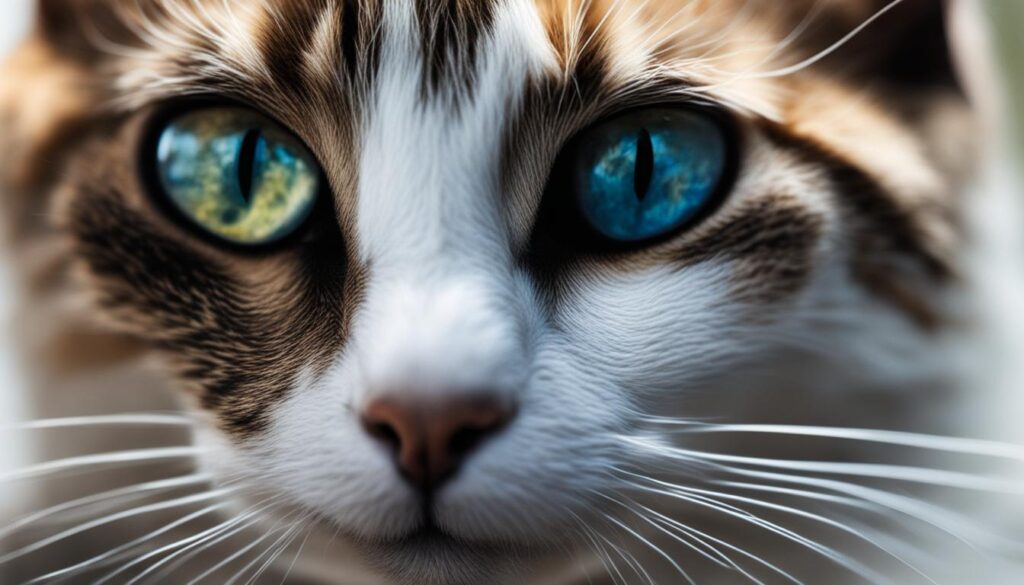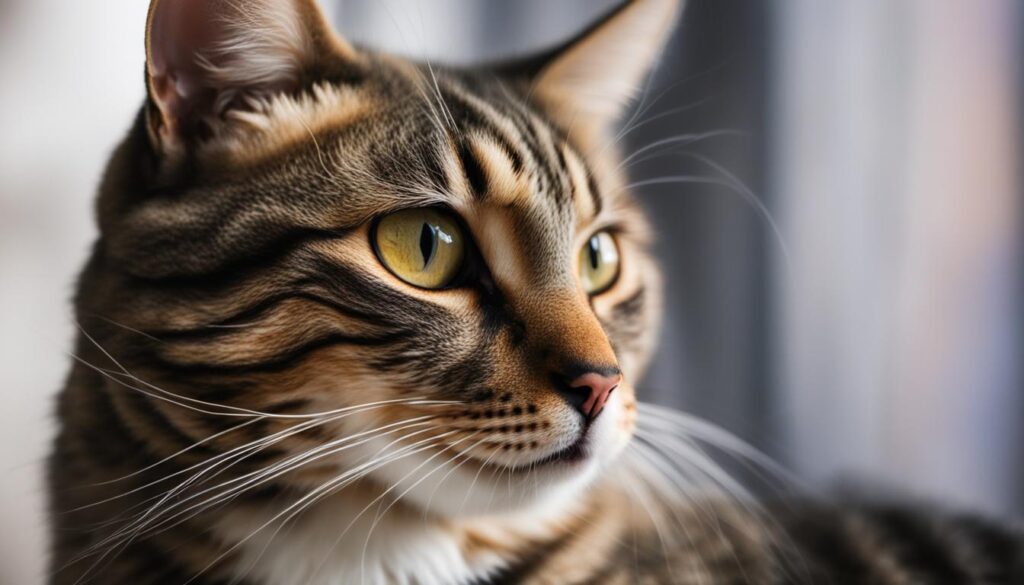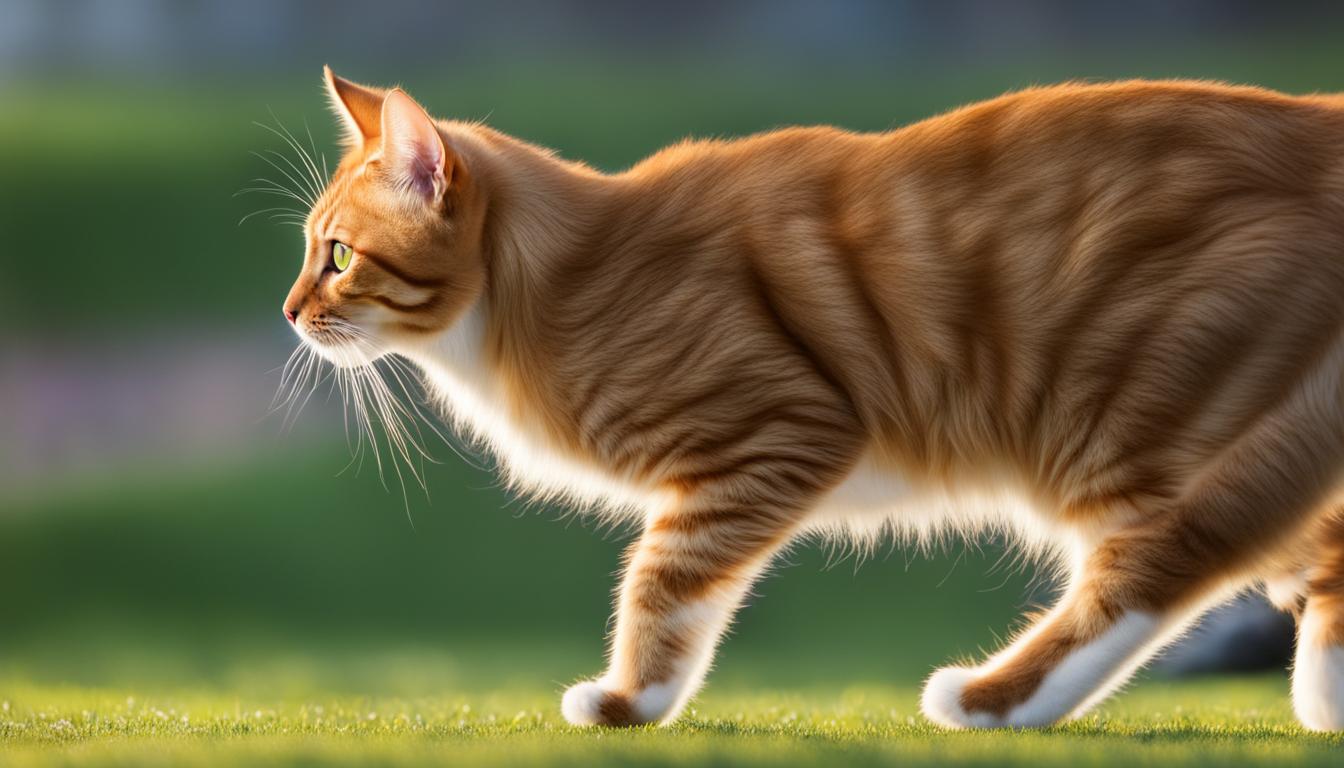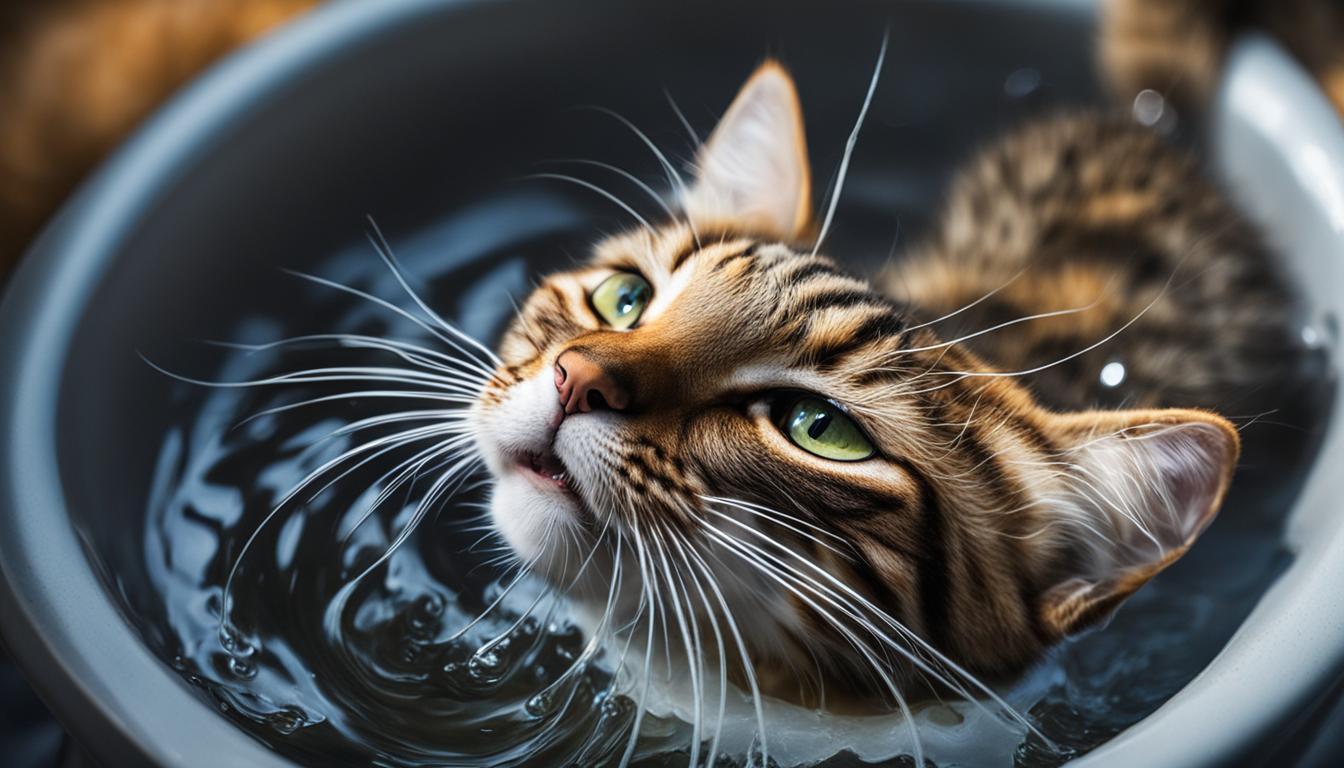Have you ever wondered how cats perceive the physical world? As a cat owner myself, I’ve always been fascinated by their unique senses and how they interact with their environment. From their keen eyesight to their acute sense of hearing, cats have evolved remarkable adaptations to navigate the world around them.
When it comes to sight, cats possess a range of abilities that set them apart. Their large eyes and specialized structure allow them to see clearly in low-light conditions, making them excellent predators during the twilight hours. But it’s not just their eyes that play a role in their perception; their whiskers and sensitive paws provide important sensory information that helps them navigate and interact with their surroundings.
In this article, we’ll delve into the fascinating world of feline perception, exploring how cats perceive the physical world through their senses of sight, sound, and touch. By understanding how cats experience their environment, we can gain insights into their behavior and ensure we meet their needs as their human companions.
Key Takeaways:
- Cats have specialized adaptations for seeing in low light, including a reflective layer called the tapetum lucidum.
- Their range of color vision is different from humans, primarily perceiving blues and greens.
- Cats possess acute hearing, with the ability to detect high-pitched sounds.
- Their whiskers and paws provide valuable tactile information about their environment.
- Understanding cat perception can help us meet their needs and foster a stronger bond with our feline companions.
The World Through a Cat’s Eyes: How Cats See the World
When it comes to seeing the world, cats have some fascinating abilities that differ from our own. Their unique visual adaptations allow them to navigate their environment, hunt effectively, and even see in the dark.

One of the key adaptations in a cat’s vision is the presence of a reflective layer behind the retina called the tapetum lucidum. This layer enhances their night vision by reflecting light back through the retina, giving them a second chance to capture any available light and improving their ability to see in low-light conditions.
While cats don’t see the full range of colors that humans do, they have excellent night vision and heightened sensitivity to motion. Their visual acuity is not as sharp as ours, but they compensate for it with their ability to see close objects with clarity. This comes in handy during hunting, allowing them to focus on prey that is nearby.
In bright light, cats’ pupils narrow to reduce the amount of light reaching their sensitive retina. This adaptation helps improve their depth of field and enhances their ability to judge distances accurately.
Table: A Comparison of Cat and Human Vision
| Aspect | Cat Vision | Human Vision |
|---|---|---|
| Color perception | Primarily see blues and greens | See a wide range of colors |
| Visual acuity | Lower than humans | Higher than cats |
| Night vision | Excellent, thanks to the tapetum lucidum | Relatively poor, especially in low-light conditions |
Understanding how cats see the world through their unique visual adaptations can help us create enriching environments that cater to their needs. By ensuring proper lighting, providing opportunities for close-range visual stimulation, and considering their sensitivity to motion, we can enhance their quality of life and strengthen our bond with these fascinating creatures.
The Ears Have It: How Cats Hear the World
The Acute Sense of Cat Hearing
When it comes to hearing, cats have an impressive range that far surpasses our own capabilities. Their ears are perfectly designed to capture even the faintest sounds, thanks to their triangular shape and 32 muscles that allow them to rotate with precision. This acute sense of hearing has been honed over years of evolution, enabling cats to detect high-pitched sounds that are barely audible to humans. It’s no wonder they make such skilled hunters!
Just like humans, cats have a range of frequencies that they can hear. However, their hearing extends much higher than ours, with some felines able to detect sounds up to 64,000 Hz, compared to our maximum of around 20,000 Hz. This enhanced frequency range allows them to pick up on subtle sounds and movements in their environment, making them highly attuned to their surroundings.
Directional Hearing: A Cat’s Superpower
One of the most fascinating aspects of cat hearing is their ability to pinpoint the source of a sound. This is made possible by their mobile ears and the way they rotate them independently. By moving each ear in different directions, cats can determine not only the location of the sound but also its distance and direction. It’s like having built-in radar!
This superpower comes in handy for hunting prey and avoiding predators. Cats can accurately locate the rustling of a mouse in the grass or the faint footsteps of a potential threat. It’s an incredible skill that showcases the precision and adaptability of their hearing abilities.
| Hearing Range | Cats | Humans |
|---|---|---|
| Lowest Frequency | 48 Hz | 20 Hz |
| Highest Frequency | 64,000 Hz | 20,000 Hz |
With their incredible sense of hearing, cats can truly appreciate the symphony of sounds in their environment. From the rustling of leaves to the softest purr, every noise tells a story that only they can hear. It’s a fascinating glimpse into the world of these remarkable creatures.

Evidence of a Cat’s Exceptional Sense of Smell
“Cats have an extraordinary sense of smell that allows them to experience the world in ways we can only imagine. Their ability to detect and interpret scents helps them navigate their environment, communicate with others, and identify potential dangers. It’s a fascinating aspect of their sensory perception that further highlights their remarkable adaptability as predators.”
– Dr. Emily Roberts, Feline Behavior Specialist
As we continue to gain a deeper understanding of how cats perceive the world through their senses, it becomes increasingly clear that their sense of smell is just as important as their sight, sound, and touch. By embracing and appreciating the role of scent in a cat’s life, we can further enrich their environment, promote positive interactions, and strengthen the bond we share with our feline companions.
The Power of Touch: How Cats Use Whiskers and Paws to Interact with the World
Cats possess an incredible sense of touch, which they utilize to navigate their environment and interact with the world around them. One of the most fascinating aspects of a cat’s tactile abilities is their whiskers, also known as vibrissae. These specialized sensory hairs are deeply rooted in the skin and contain a wealth of information about the surrounding environment. The whiskers are highly sensitive to even the slightest air movements, allowing cats to detect objects in their path and judge distances with remarkable precision.

When a cat is hunting or exploring a new space, their whiskers move forward, forming a distinctive basket shape. This configuration helps them to gather additional tactile information, compensating for any limitations in their visual perception. It’s astonishing to think that cats can effectively “see” and feel their surroundings using their whiskers in conjunction with their other senses.
Beyond their whiskers, cats also rely on their sensitive paws to interact with the world. These paws contain specialized touch receptors that enable them to feel variations in texture and detect subtle vibrations. Cats use their paws not only for walking but also for several other crucial activities.
Exploring and Marking Territory
Cats use their paws to explore their surroundings, reaching out and touching objects to gather information about their environment. They carefully investigate new scents, textures, and surfaces using their highly sensitive paw pads. Additionally, cats use their paws to mark their territories by scratching, leaving a visual and olfactory message for other cats.
Interacting with Objects
Cats exhibit their natural predatory instincts by using their paws to interact with objects. Whether it’s batting at a toy mouse or playing with a ball, their paw-eye coordination allows them to hone their hunting skills. The sensitivity of their paws enables them to make precise movements and carefully manipulate objects during play.
Forming Emotional Connections
Finally, cats use their paws to form emotional connections with their human companions. Through gentle kneading, they express affection and contentment, a behavior often associated with their early kittenhood when they kneaded their mothers’ bellies to stimulate milk production. The touch between a cat’s paws and their human’s skin can help strengthen the bond between them.
In conclusion, cats possess an incredible sense of touch that they use to navigate their environment, interact with objects, and communicate with both other cats and humans. Their whiskers and sensitive paws allow them to gather valuable information about their surroundings, providing them with a unique perspective on the world. By understanding and appreciating the power of touch in a cat’s sensory experience, we can forge stronger connections and create enriching environments for our feline companions.
Conclusion
As I wrap up this exploration of how cats perceive the physical world, I am truly amazed by the remarkable senses that felines possess. Their keen eyesight, acute hearing, and sensitive touch all play a crucial role in shaping their understanding of the environment around them.
By understanding how cats perceive the world through their senses, we can gain valuable insights into their behavior and needs. This knowledge allows us to create an environment that caters to their unique sensory experiences, providing appropriate stimuli and enrichment.
When we respect and accommodate their sensory preferences, we foster a stronger bond with our feline companions. It becomes easier to communicate and meet their needs, leading to happier and more fulfilled cats.
So, let us continue to explore the fascinating world of cat perception, always striving to understand and appreciate the feline senses. By doing so, we ensure that our cats live their lives to the fullest, and we get to enjoy the incredible journey alongside them.
FAQ
How do cats see in the dark?
Cats have a reflective layer called the tapetum lucidum behind their retinas, which enhances their night vision. This layer reflects light back through the retina, giving them a second chance to detect it. Their eyes are also larger compared to their body size, allowing them to gather more light in low-light conditions.
What colors can cats see?
Cats primarily see blues and greens. They have a different range of color vision compared to humans, as they lack certain color receptors. While their color vision may not be as vibrant as ours, they make up for it with their ability to see movement and detect contrasts.
How do cats hear better than humans?
Cats have a broad range of hearing and can detect high-pitched sounds that are barely audible to humans. Their triangular-shaped ears and 32 muscles allow them to rotate their ears and pinpoint the source of sounds, helping them locate prey and avoid predators.
How do cats use their sense of smell?
Cats have a highly developed sense of smell, with 200 million odor-detecting cells compared to humans’ five million. They use their sense of smell to navigate their environment, detect other cats and people, and identify potential threats. Cats also use scent marking to communicate with other cats, leaving their scent through urine, feces, and scent glands on different parts of their body.
How do cats use their whiskers and paws?
Cats rely on their whiskers, known as vibrissae, to gather vital information about their surroundings. Whiskers are highly sensitive and help cats detect nearby air movements and objects, improving their spatial awareness. Whiskers also play a role in hunting, as they move to form a basket shape when a cat is unable to see its prey. Cats also use their sensitive paws to explore their environment, mark territory, and interact with objects.
How can understanding cat perception help us?
Understanding how cats perceive the physical world through their senses can help us provide appropriate environmental enrichment, meet their needs, and better understand their behavior. By respecting and catering to their unique sensory experiences, we can foster a stronger bond with our feline companions and create a more enriching environment for them.





